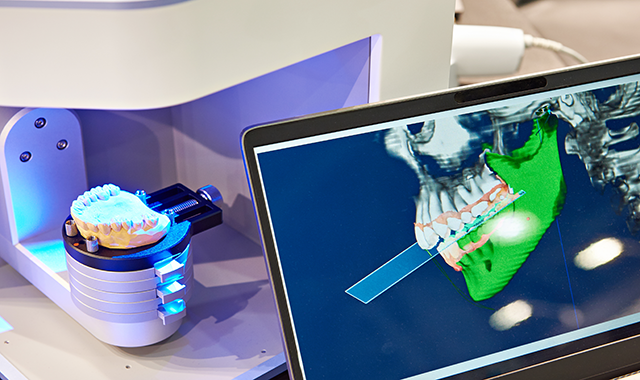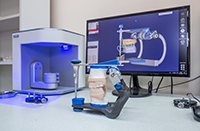Comparing Denture Fabrication Processes: Which One is Best for Your Patients?
When it comes to making denture bases, which digital fabrication process is right for your patients? Two studies give us insight into this critical issue.

CAD/CAM technology has been enhancing the denture fabrication process with digitally fabricated dentures in recent years. From advances in scanning technology to increased material options, the digital fabrication process for complete dentures is growing in popularity with many labs and clinicians.
Making dentures the conventional way with polymethylmethacrylate (PMMA) has been standard operating procedure for many labs and technicians since the end of the 1930s.[i] Eighty years later, acrylic resin is still the material of choice for dentures. However, how we fabricate them out of the material has been changing.
CAD/CAM complete dentures have many advantages over conventionally fabricated dentures. A review of the literature from 1994 to March 2018 published last year concluded that digital fabrication of full dentures enjoy the following benefits from clinical studies:[ii]
- Reduced clinical chair time
- Fewer appointments for denture delivery
- Digital archiving for future reference (and replacements)
- Improved retention
- Improved clinical and patient outcomes
Continue reading on the next page...
A review of literature from the same period for laboratory studies revealed the following benefits of CAD/CAM Complete dentures as well:[iii]
- Better mechanical and physical properties
- Improved accuracy regarding fit of milled denture bases
- A decrease in the denture tooth movement and an increase in durability
- Excellent flexural strength
- Increased elastic modulus
With benefits like these, digital fabrication is growing in popularity with some labs and clinicians. There are two methods of digital manufacturing of complete dentures, additive and subtractive, otherwise known as 3D printing and milling, respectively.

However, which type of digital fabrication creates the best dentures for your patient? Two recent studies have taken a closer look at this question this year. Both studies chose the denture base as the comparison because it is essential to retention for the patient. Moreover, as the Journal of Advance Prosthodontics points out, the denture base has a significant influence on the clinical treatment results.[iii] Furthermore, the researchers expected them to all have the same accuracy and resolution.
Were they right? Here’s what they found out.
Continue reading on the next page...
CAD-CAM Milled versus rapidly prototyped (3D-printed) complete dentures: An in vitro evaluation of trueness
The Journal of Prosthetic Dentistry published a study, “CAD-CAM Milled versus rapidly prototyped (3D-printed) complete dentures: An in vitro evaluation of trueness,” summarized the problem well in early 2019. Of the two principal methods of fabrication, there were some questions as to whether the prostheses produced by these methods were accurate. The researchers for the study sought to determine the difference in trueness between the complete dentures produced each way.[iv]
To test it, they created two groups of complete maxillary dentures from a reference maxillary edentulous model. Then, they scanned the interior surface of the dentures. Next, they immersed them in an artificial saliva solution for three weeks and scanned the interiors again. After the second scan, they had a wet-dry cycle, where the dentures were immersed in the artificial saliva during the day and left to dry at night for another three weeks. Then, another scan was performed.[v]
After collecting the scans, they used a 3D comparison software program to analyze the variances in the trueness of the complete dentures. They compared the scans at the:[vi]
- Intaglio surface
- Posterior crest
- Palatal Vault
- Posterior Palatal Seal Area
- Tuberosity
- Anterior Ridge
- Vestibular Flange
- Mid-Palatal Raphe
Continue reading on the next page...
What they found was that the trueness of the milled complete dentures was much better than the 3D printed group in all the areas they measured. The researchers also determined that further studies on biomechanical, clinical, and patient-centered outcome measures were needed to say whether one fabrication method was better than the other for complete dentures.[vii]
Comparing the accuracy of denture bases fabricated by injection molding, CAD/CAM milling, and rapid prototyping method
The Journal of Advanced Prosthodontics published in February 2019 a study “Comparing accuracy of denture bases fabricated by injection molding, CAD/CAM milling, and rapid prototyping method,” out of the Korean Academy of Prosthodontics. The researchers also wanted to check the accuracy of denture bases.[viii]
To compare bases, the researchers made a maxillary edentulous master cast, and they formed four round-shaped notches. Next, they made ten casts and scanned them.[ix]
The following step was to create each of the bases using the different fabrication methods. For the injection-molded examples, the denture bases were milled from a wax block and made using the SR Ivocap injection system. For the milled process, the denture bases were manufactured using pre-polymerized blocks. The 3D printed samples were printed and post cured.

There were a few ways the researchers compared the bases. First, they scanned the intaglio surface and then used software to measure any inaccuracies. Second, they measured the distance between the four notches from the master cast and the two points in the mid-palatal suture. They also evaluated the palatine rugae resolution (with a one-way analysis of variance of a=.05).[xi]
Continue reading on the next page...
The results were a bit of a mixed bag. There weren’t significant differences in the notch measurements between the three methods. Injection molding was the least accurate by the mid-palatal suture when compared to milled or 3D printed dentures. However, the degree of palatine rugae resolution was better in injection molding than the other methods.[xii]
What the researchers learned here was that the overall accuracy of milled and 3D printed denture bases is higher than injection molded ones. They attribute this fact to polymerization shrinkage and internal stress imposed on the injection-molded versions. However, injection molding was superior at the “degree of fine reproducibility” when compared to the other methods. This finding was the result of measuring the vertical difference between the highest and the lowest points in the palatine rugae area. [xiii]
So, What Does This Mean to Your Patients?
The first study found that milled dentures have better trueness than 3D printed ones. The second study found that regarding reproducibility, injection-molded dentures were better than digitally produced ones, but that digitally fabricated dentures were more accurate than injection molded. So, the studies have some guidance about what is the most accurate or what might be best for reproduction, but not a clear choice or all the answers just yet.
One thing is clear; the demand for dentures is higher than ever before. Finding ways to serve the edentulous population better and faster is a priority for the dental industry. While research has yet to proclaim a clear winner for the best digital fabrication process between milling or 3D printing for making full dentures yet, these studies are underway.
Regardless, the literature suggests the way forward for complete dentures is digital fabrication technology. Whether you choose to have them printed or milled, there are many benefits to your clinical and patient outcomes.
References:
[i] “History of Dentures – Invention of Dentures.” Historyofdentistry.net. Web. 9 October 2019. < http://www.historyofdentistry.net/dentistry-history/history-of-dentures/>.
[ii] Janeva, Nadica Mihajlo et al. “Advantages of CAD/CAM versus Conventional Complete Dentures - A Review.” Open access Macedonian journal of medical sciences vol. 6,8 1498-1502. 4 Aug. 2018, doi:10.3889/oamjms.2018.308
[iii] Lee S, Hong SJ, Paek J, Pae A, Kwon KR, Noh K. Comparing accuracy of denture bases fabricated by injection molding, CAD/CAM milling, and rapid prototyping method. J Adv Prosthodontics. 2019 Feb;11(1):55-64. https://doi.org/10.4047/jap.2019.11.1.55.
[iv] Kalberer N, Mehl A, Schimmel M, Müller F, Srinivasan M. CAD-CAM milled versus
rapidly prototyped (3D-printed) complete dentures: An in vitro evaluation of
trueness. J Prosthet Dent. 2019 Apr;121(4):637-643. doi:
10.1016/j.prosdent.2018.09.001. Epub 2019 Jan 31. PubMed PMID: 30711292.
10.1016/j.prosdent.2018.09.001. Epub 2019 Jan 31. PubMed PMID: 30711292.
09.001. Epub 2019 Jan 31. PubMed PMID: 30711292.
[v] Ibid.
[vi] Ibid.
[vii] Ibid.
[viii] Lee S, Hong SJ, Paek J, Pae A, Kwon KR, Noh K. Comparing accuracy of denture bases fabricated by injection molding, CAD/CAM milling, and rapid prototyping method. J Adv Prosthodont. 2019 Feb;11(1):55-64. https://doi.org/10.4047/jap.2019.11.1.55
[ix] Ibid.
[x] Ibid.
[xi] Ibid.
[xii] Ibid.
[xiii] Ibid.